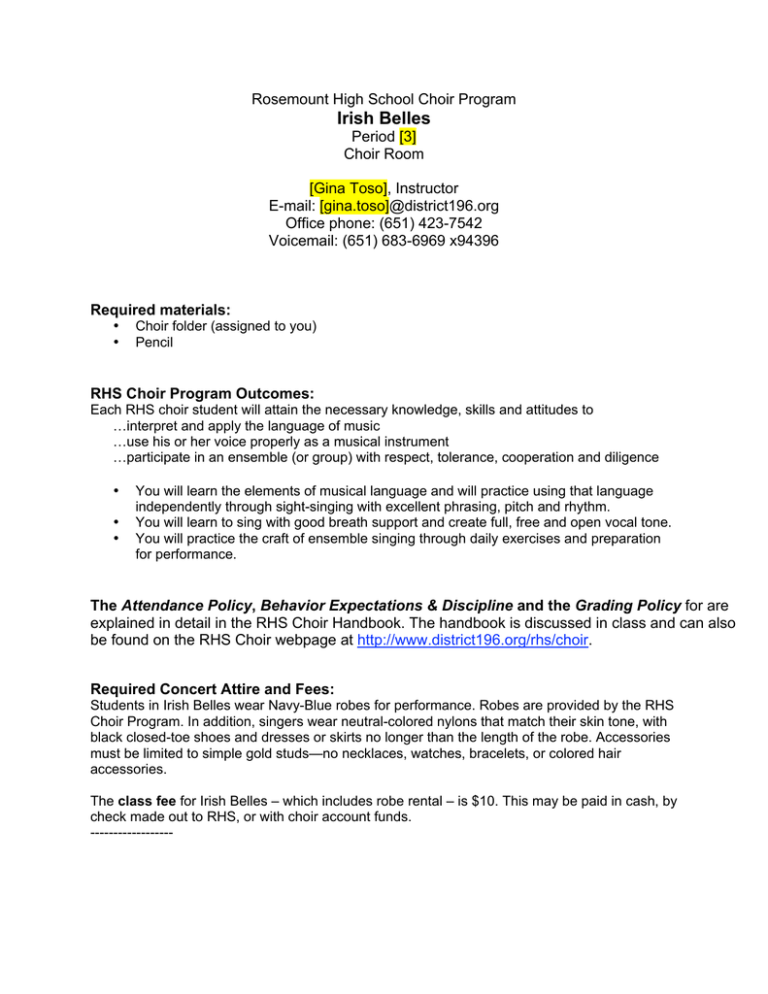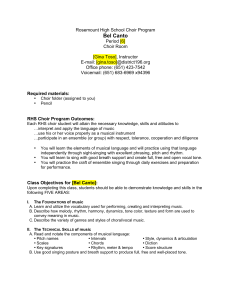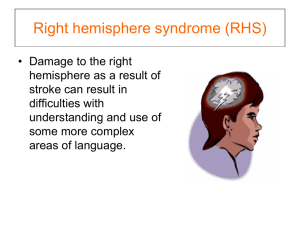Irish Belles
advertisement

Rosemount High School Choir Program Irish Belles Period [3] Choir Room [Gina Toso], Instructor E-mail: [gina.toso]@district196.org Office phone: (651) 423-7542 Voicemail: (651) 683-6969 x94396 Required materials: • • Choir folder (assigned to you) Pencil RHS Choir Program Outcomes: Each RHS choir student will attain the necessary knowledge, skills and attitudes to …interpret and apply the language of music …use his or her voice properly as a musical instrument …participate in an ensemble (or group) with respect, tolerance, cooperation and diligence • • • You will learn the elements of musical language and will practice using that language independently through sight-singing with excellent phrasing, pitch and rhythm. You will learn to sing with good breath support and create full, free and open vocal tone. You will practice the craft of ensemble singing through daily exercises and preparation for performance. The Attendance Policy, Behavior Expectations & Discipline and the Grading Policy for are explained in detail in the RHS Choir Handbook. The handbook is discussed in class and can also be found on the RHS Choir webpage at http://www.district196.org/rhs/choir. Required Concert Attire and Fees: Students in Irish Belles wear Navy-Blue robes for performance. Robes are provided by the RHS Choir Program. In addition, singers wear neutral-colored nylons that match their skin tone, with black closed-toe shoes and dresses or skirts no longer than the length of the robe. Accessories must be limited to simple gold studs—no necklaces, watches, bracelets, or colored hair accessories. The class fee for Irish Belles – which includes robe rental – is $10. This may be paid in cash, by check made out to RHS, or with choir account funds. ------------------ Class Objectives for [Irish Belles]: Upon completing this class, students should be able to demonstrate knowledge and skills in the following FIVE AREAS: I. The FOUNDATIONS of music A. Learn and utilize the vocabulary used for performing, creating and interpreting music. B. Describe how melody, rhythm, harmony, dynamics, tone color, texture and form are used to convey meaning in music. C. Describe the variety of genres and styles of choral/vocal music. II. The TECHNICAL SKILLS of music A. Read and notate the components of musical language: • Pitch names • Intervals • Style, dynamics & articulation • Scales • Chords • Diction • Key signatures • Rhythm, meter & tempo • Score structure B. Use good singing posture and breath support to produce full, free and well-placed tone. III. The CONTEXTS of music A. Explain the cultural, historical and social contexts that influence the creation, interpretation or performance of different types of music being studied/rehearsed. B. Describe the similarities and differences among characteristics of music and other art areas. IV. Music REHEARSAL & PERFORMANCE A. Rehearse and perform multiple works of music in a variety of styles. B. Reflect on and refine musical performance using multiple sources of critique/feedback. C. Justify musical choices based upon knowledge of the Foundations (I), Technical Skills (II) and Contexts (III) of music. D. Demonstrate excellent rehearsal skills, including respect, cooperation and best effort. V. ANALYSIS & CRITIQUE of music A Analyze, interpret and evaluate a variety of musical works and performances based upon knowledge of Foundations (I), Technical Skills (II), Contexts (III) and Rehearsal & Performance (IV) of music. B. Justify and defend personal reactions to a variety of musical works and performances.







